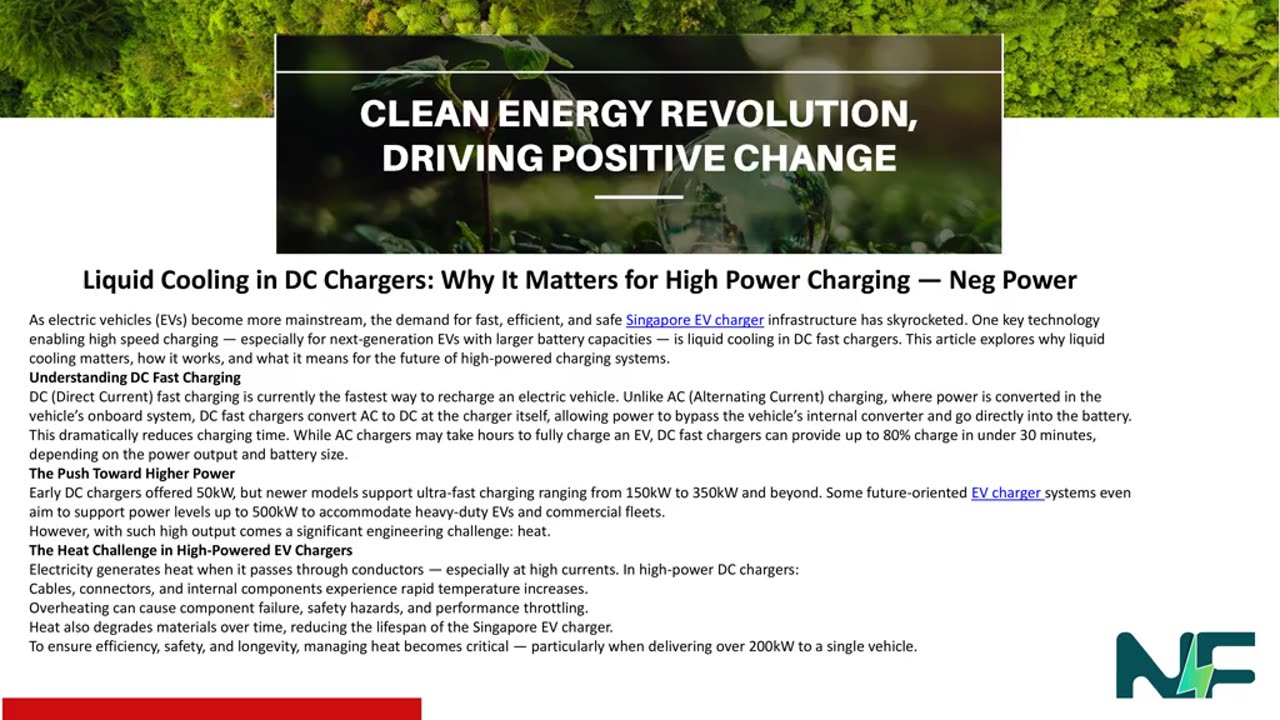Premium Only Content

Liquid Cooling in DC Chargers: Why It Matters for High Power Charging — Neg Power
As electric vehicles (EVs) become more mainstream, the demand for fast, efficient, and safe Singapore EV charger infrastructure has skyrocketed. One key technology enabling high speed charging — especially for next-generation EVs with larger battery capacities — is liquid cooling in DC fast chargers. This article explores why liquid cooling matters, how it works, and what it means for the future of high-powered charging systems.
Understanding DC Fast Charging
DC (Direct Current) fast charging is currently the fastest way to recharge an electric vehicle. Unlike AC (Alternating Current) charging, where power is converted in the vehicle’s onboard system, DC fast chargers convert AC to DC at the charger itself, allowing power to bypass the vehicle’s internal converter and go directly into the battery.
This dramatically reduces charging time. While AC chargers may take hours to fully charge an EV, DC fast chargers can provide up to 80% charge in under 30 minutes, depending on the power output and battery size.
The Push Toward Higher Power
Early DC chargers offered 50kW, but newer models support ultra-fast charging ranging from 150kW to 350kW and beyond. Some future-oriented EV charger systems even aim to support power levels up to 500kW to accommodate heavy-duty EVs and commercial fleets.
However, with such high output comes a significant engineering challenge: heat.
The Heat Challenge in High-Powered EV Chargers
Electricity generates heat when it passes through conductors — especially at high currents. In high-power DC chargers:
Cables, connectors, and internal components experience rapid temperature increases.
Overheating can cause component failure, safety hazards, and performance throttling.
Heat also degrades materials over time, reducing the lifespan of the Singapore EV charger.
To ensure efficiency, safety, and longevity, managing heat becomes critical — particularly when delivering over 200kW to a single vehicle.
Why Liquid Cooling Is Essential
Enter liquid cooling technology — an innovation that addresses thermal management challenges in ultra-fast Singapore EV chargers.
Liquid cooling uses a coolant (typically a water-glycol mixture) to actively extract heat from power electronics, cables, and connectors. This method is significantly more efficient than air cooling, especially when dealing with the intense thermal loads of high-power systems.
Key Benefits of Liquid Cooling:
Supports Higher Currents
With proper liquid cooling, charging cables can safely handle currents above 500 amps, enabling ultra-fast charging without overheating.
Compact Cable Design
Air-cooled high-power cables are bulky and heavy. Liquid-cooled cables are lighter, thinner, and easier to handle, improving the user experience.
Enhanced Safety
Lower operating temperatures reduce the risk of burns, equipment damage, or fire hazards.
Increased Charging Speed
Heat buildup often causes systems to throttle charging speeds. Liquid cooling keeps systems within safe operating limits, maintaining maximum power output longer.
Improved Reliability
Consistent temperature control means less thermal stress on components, leading to longer equipment lifespan and reduced maintenance costs.
How Liquid Cooling Works in EV Chargers
The basic principle of liquid cooling in EV charger systems is simple: heat is absorbed by a liquid coolant and transferred to a heat exchanger or radiator where it is dissipated.
Major Components Include:
Coolant-embedded charging cables: Designed with internal fluid channels.
Pumps and reservoirs: To circulate coolant continuously.
Heat exchangers: Transfer heat from the coolant to the environment.
Sensors and controllers: Monitor temperature and regulate flow rates.
This closed-loop system ensures that every part of the charger stays within its thermal safety limits, even during continuous high-power sessions.
Use Cases Requiring Liquid Cooling
While liquid cooling may seem like an advanced option, it’s becoming essential for:
Public EV fast-charging stations on highways or transit hubs.
Fleet depots where commercial EVs (e.g., buses, trucks) are charged rapidly and frequently.
Battery swapping stations where high-speed recharging of standby batteries is needed.
Urban areas with high traffic and frequent charger usage, where cooling efficiency ensures charger availability and uptime.
In short, anywhere ultra-fast charging is deployed, liquid cooling becomes more than a luxury — it’s a necessity.
Environmental Considerations
Some may worry that liquid cooling systems might pose environmental risks, especially regarding leaks or coolant disposal. However:
Most modern coolants are non-toxic and biodegradable.
Systems are built to be sealed and low-maintenance.
Regular diagnostics and leak detection sensors minimize risk.
Liquid-cooled Singapore EV charger systems are also more energy efficient, reducing overall power loss due to heat and improving system sustainability.
The Future of High-Power Charging
With more EVs being released with larger batteries and faster charging capabilities, infrastructure must keep pace. Automakers are moving toward 1000V architecture in EVs, which will demand charging systems capable of supplying high voltages and currents safely and reliably.
Liquid cooling will be a foundational technology enabling:
Shorter charging times (under 10 minutes for 80% charge)
Expansion of heavy-duty EV fleets (trucks, buses, delivery vans)
Mass deployment of public charging infrastructure
Smarter thermal load balancing in Singapore EV charger networks
Conclusion
As we enter a new era of electric mobility, the ability to deliver massive amounts of power quickly, safely, and sustainably is key. Liquid cooling is not just a technical add-on — it’s a strategic enabler of high-powered EV charging.
From managing intense heat loads to supporting future-proof infrastructure, liquid-cooled \ EV chargers in Singapore will be essential in meeting the evolving needs of drivers, fleet operators, and energy providers alike.
When selecting or deploying an EV charger for high-power applications, make sure it incorporates liquid cooling technology. It’s not just about speed — it’s about safety, performance, and long-term value.
Pop over here : https://www.negpower.sg/ev-charger-ac-dc/
-
 UPCOMING
UPCOMING
Daniel Davis Deep Dive
2 hours agoCol Doug Macgregor: Ukraine Russia Peace Proposal Moscow Awaits Official Version
60 -
 1:31:20
1:31:20
Graham Allen
3 hours agoPentagon DROPS HAMMER on Sen. Kelly for Urging Troops to DEFY Orders!! Sedition Exposed!
121K480 -
 LIVE
LIVE
Badlands Media
11 hours agoBadlands Daily: November 25, 2025
3,523 watching -

Wendy Bell Radio
7 hours agoYou Realize We Voted For This.
54K84 -
 26:00
26:00
Neil McCoy-Ward
4 hours agoAnd So It Begins… ('Carbon' Food Quotas Are HERE)
14.6K7 -
 LIVE
LIVE
The Big Mig™
3 hours agoWTF? Letitia James & James Comey Charges Dropped
2,741 watching -
 1:09:24
1:09:24
Chad Prather
17 hours agoWe Must Obey God: The Gospel That Cannot Be Silenced
78.6K26 -
 1:04:27
1:04:27
The Mike Schwartz Show
3 hours agoTHE MIKE SCHWARTZ SHOW with DR. MICHAEL J SCHWARTZ 11-25-2025
10.4K6 -
 4:50
4:50
Captain Peach
6 days ago $7.42 earned5 Ways Game Trailers Lie
62.3K4 -
 18:06
18:06
We Got Receipts
20 hours agoLatest EBT Meltdowns That Are Actually Funny!
33.6K28